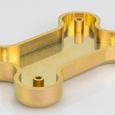Machining of metal or plastic plays a huge role in parts production. In many cases, machined surface finishes are more than adequate for end-use applications, but because part surfaces are cut, rather than cast or molded, the standard (as-machined) surface finish sometimes needs to be modified for either aesthetic or functional purposes. This can require either more precise machining or the use of secondary processes.
Measuring Surface Roughness
The most widely used measure of surface roughness is Ra, or average surface roughness. It measures deviation from the mean surface plane in micro-inches. For example, the coarse surface of a cast iron frying pan has an Ra of about 2,000. The ultra-smooth surface of the Hubble Space Telescope’s mirror is as close to zero as can be achieved (although a flaw less than one-fiftieth the size of a human hair was found and did require repair). Machined parts tend to fall somewhere in between these two figures.

Sometimes, roughness on a machined surface is acceptable. Typically for aesthetic reasons, a rougher-than-as-machined surface is preferred. A matte finish can eliminate reflections and is less likely to show marks. But matte finishes can’t be achieved simply by machining. For that, you need secondary processes such as bead blasting or tumbling with a ceramic substrate.
Smoother Surfaces
There are several different ways to achieve a smoother surface finish on a machined part. The first factor in surface finish is determined by the machining process itself, allowing you to strike a balance between speed and smoothness. If you need your part faster, expect an Ra of 60 to 65. If you can work with a longer turnaround, that figure drops to a potential Ra of 32.
What can you expect from your parts? We break (debur) the edges on all machined parts. All machined plastic parts are left as-machined, which may leave visible tool marks. Some metal parts, on the other hand, allow more choice. It’s important to remember that precision-machined parts often have sharp edges and should be handled with care.

If you want a detailed look at all of our design specs, these CNC milling guidelines provide all of the info you need.
Still, the higher roughness of Ra 60 isn’t what we normally think of as “rough.” At an Ra of 60, a surface will have visible tooling swirls but won’t feel rough to the touch. You’d need a microscope to see the surface variations. Occasionally, depending on the application, this amount of roughness can lead to incremental wear in a moving part and cause weakness where a part is stressed. It might even allow corrosion to get a foothold on your parts. That’s where secondary processes come in.
Post-process Finishing
Secondary finishing processes are incredibly important, and we have multiple options to attain enhanced levels of finished machined parts. Machined surfaces are typically smoothed by graining or lapping. The two are similar but use different equipment. In either case, the part is drawn repeatedly across a series of increasingly fine-textured abrasives until the desired surface smoothness is achieved. Depending on how many steps are applied, graining can achieve a final surface finish between Ra 4 and 32. Lapping can produce surface Ra between 2 and 16. It should come as no surprise that lapping is the process used to produce precision astronomical telescope mirrors. While there is overlap in the relative smoothness that can be achieved by either graining or lapping there are a variety of factors, including price, that can make one or the other your process of choice.
As with metal parts, machined plastic parts can use various processes to adjust their surface finishes. Be aware that plastic parts could be damaged by bead blasting, but if you are willing to accept that risk, it can be done. More typically though, if a matte finish is needed on plastic parts, injection molding is used so the metal mold itself is bead blasted to impart the rougher finish to the resulting parts.
For a shinier finish, machined plastic parts can be polished using wet-sanding. As with metal graining, progressively finer grit is applied until the desired finish is achieved. There is one other treatment method for smoothing machined plastic surfaces, particularly those of clear plastics in optical applications. Machining, even with fine tools, will usually cloud the surface of a clear plastic part, something that would be unacceptable if the part is something like a lens. In those cases, flame polishing applies just enough heat to flatten the light-scattering “hills and valleys” on the part surface. This lets light pass through the part as it should, rather than be scattered by the microscopic “geography” of its surface. To the naked eye, the part’s appearance will change from cloudy to clear.
Whatever the desired finish of your machined part—whether more matte or more polished than “as-machined”—there may be several ways to achieve it. These can include the choice of machining process itself or using secondary processes. The best approach for any part really depends on your application, timeframe, production volume, budget, and the exact finish you need. Because changes to machined parts can be done fairly quickly, you may be able to try several options and see which one works best for you. Our interactive quotes with manufacturability feedback provide useful information in making those decisions, but sometimes you may need help from our support engineers to narrow down your choices. We’re here to help.
If you want to get a really detailed look at our finishing options, download our FREE Surface Finish Guide for CNC Machining.

If you have any issues getting your guide, download here.


Upload a 3D CAD file to get an online CNC quote.
Upload a Part







